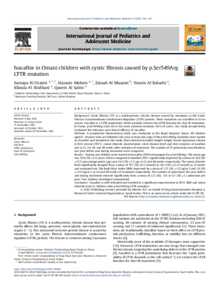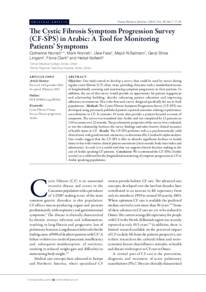Document
Ivacaftor in Omani children with cystic fibrosis caused by p.Ser549Arg CFTR mutation.
Identifier
DOI: 10.1016/j.ijpam.2021.10.003
Source
International Journal of Pediatrics and Adolescent Medicine. v. 9, 2, p. 104-107
Contributors
Mohsin, Hussain., Author
Al-Musawiyah, Zainab., Author
Al-Balushi, Younis., Author
Al-Shidhaniyah, Khoula., Author
Al-Salmi, Qasem., Author
Country
Saudi Arabia.
Publisher
King Faisal Specialist Hospital and Research Centre.
Gregorian
2022-06-01
Language
English
Subject
English abstract
Background: Cystic fibrosis (CF) is a multisystemic chronic disease caused by mutations in the Cystic Fibrosis Transmembrane Conductance Regulator (CFTR) protein. These mutations are classified in to six classes. Ivacaftor is a CFTR potentiator which partially restores the CFTR function for class III mutations. In Oman, p.Ser549Arg (class III) is the most common mutation (65% of cases). Our study prospectively evaluated the tolerance and clinical efficacy of ivacaftor. Methods: A prospective observational study was conducted at the Royal Hospital, Oman. All children aged 6–18 years who are followed and carry at least one copy of the p.Ser549Arg mutation were started on Ivacaftor and included in the study. Data collected included weight, height, forced expiratory volume in first second (FEV1), sweat chloride concentration, stool elastase level and liver enzymes at baseline and at 12, 24, 36, and 48 weeks after initiation of treatment. The number of CF pulmonary exacerbations one year before and during treatment were compared. Results: Twenty one children were started on Ivacaftor (90% homozygous for p.Ser549Arg). The mean age was 10.8 (SD ±3.5) years. When compared to baseline, FEV1 significantly improved by a mean of 10.8 (SD ±13.5) percentage points (pp) and 14.3 (SD ±7.5) pp at 12 and 48 weeks respectively. The sweat chloride level significantly dropped from a mean of 107 (SD ±8.5) mmol/l to 38.5 (SD ±22.3) mmol/l at 12 weeks and remained low. The Body Mass Index (BMI) improved by a mean of 1.37 (SD ±1.3) kg/m 2 and 1.9 (SD ±1.35) kg/m 2 at 24 and 48 weeks of treatment respectively. The number of admissions the year before and during treatment reduced significantly from a mean of 2.2 (SD± 1.9) to 0.7 (SD ±1) admission per year. Two children developed transaminitis. Conclusion: Ivacaftor is well tolerated and resulted in a significant improvement in FEV1, BMI and sweat chloride level in children with p.Ser549Arg CFTR mutation.
ISSN
2352-6467
Category
Journal articles


